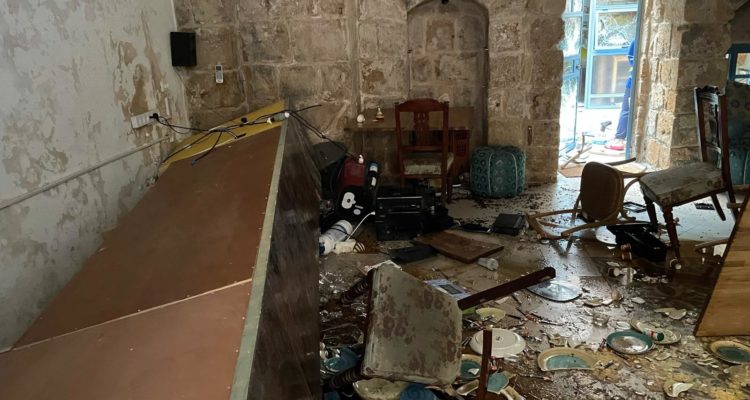Is there an invisible wall between the Jewish and Arab residents of Israel’s mixed cities? The May 2021 conflict with Hamas may have exposed it.
By Sheri Oz, World Israel News
We learned recently that 17 Jewish men who were arrested in Ramla in May 2021 were finally awarded NIS 5,000 each as compensation for false arrest.
This reminder of events in the mixed towns within Israel that took place as almost 4,500 missiles were launched at civilian targets from Gaza affords us the opportunity to reflect on what happened last spring from a position that is less tinged with the emotionality of that time.
Reminded of the circumstances of their arrest and the de facto admission by the police that they were wrongly apprehended, we can consider the ramifications and lessons derived from seeing the degree of unpreparedness of our security forces for the outbreak of violence between Jews and Arabs within the state.
In Israel, we give names to hostilities with our neighbors that are beneath the threshold of out-and-out war. The last one, lasting for 11 days in mid-May 2021, was called Guardian of the Walls.
We can surely ask what walls Israel was guarding because today, when infantry battles are certainly not the norm, a physical wall is irrelevant. There is, of course, the Security Wall in Judea-Samaria between land under the auspices of the Palestinian Authority and that under Israeli control that prevents terrorist infiltration to a great extent, but this wall was not threatened last spring.
Israelis were not surprised by missiles from Gaza. After all, for several years southern Israel has seen multiple missile launchings as well as incendiary kites and balloons that set fire to natural forest and farmland. While certainly scary, we seem to accept the threat as part of life in Israel.
Rather, the greatest impact of the hostilities was felt in the joint Arab-Jewish towns, such as Akko, Lod, Haifa, Jaffa, Ramla. What walls had to be guarded in these cities?
Wall of denial?
Is there an invisible “virtual” wall between the Jewish and Arab residents of these cities? There is the saying that good fences make good neighbors, but is there a fence between Arabs and Jews in mixed towns? After all, while their kids do not attend the same schools, they play in the same playgrounds, shop in the same stores, walk the same streets, work side-by-side in many enterprises and offices.
So perhaps the wall is a psychological one, a mutually agreed-upon delicate status quo because the alternative is what we saw last May.
Perhaps the wall is a wall of denial – many Jewish citizens and leaders believing that, while a certain proportion of Arabs are not happy having citizenship in a Jewish country, they would nevertheless not rise up against the state. Perhaps that is the wall that was punctured last spring.
And that would not be a wall worth guarding, rather one worth taking down.
Had the Arabs in the mixed towns not arisen against their Jewish neighbors, it’s possible that these cities would have experienced the Gazan operation uneventfully. Had they not arisen against their neighbors so violently, would the men who battered an innocent Arab driving his car in Bat Yam have been emboldened enough to attempt the lynch? Certainly, there is no excuse for that reprehensible attack.
The attempted lynch also shows what might have happened around the country had order not been restored when it finally was. It shows the very delicate and unstable balancing act we maintain.
Leadership caught unprepared
Given the wall of denial, the leadership was caught unprepared. A ready leadership would have had plans of action pre-determined for such an eventuality. Like the army that trains for alternative scenarios in battle, there would have been plans a, b, and c, and the various units responsible for internal security would have functioned like a Swiss watch to quickly bring quiet, if not peace.
A Hebrew-language video summarizes the Jewish experience in Lod at that time. Called “Five Days in May,” it shows how helpless the residents of Lod felt when police did not respond for hours or at all to their pleas for protection.
In fact, one interviewee remarked that the first time the police got involved was when an Arab citizen was killed by a Jew.
It is, perhaps, surprising that Jewish vigilantism did not become a more serious problem. After all, Arabs entered the yards of their Jewish neighbors, threw rocks through windows and even set one family’s apartment alight.
According to the film, the situation is quiet now, but the tension has not dissipated. Will relationships return to the earlier level of trust and sense of living in a shared space?
Israelis who do not live in any of the mixed cities may have largely gone “back to normal,” but no one will be surprised if such violence erupts again in the future. One can only hope that the security services are now putting together their plans a, b, and c in anticipation of hostilities that yet await us.
They called the operation “Guardians of the Walls.” But given the lessons of May 2021, the truly salient wall in Israeli society is twofold: the wall of psycho-social distance between Muslims and Jews in the country and the wall of denial on the part of our leadership that prevents properly coping with the challenges inherent in this.
We should not be “guarding” these walls; we need to manage them, confront them, overcome them. How? That should be the subject of vigorous debate among all of us.





